TETOUAN JOURNAL
Tetouan, the Paradise Rediscovered
Elegant, luminous, Tetouan spreads its charm in the hollow of Jbel Darsa, gazing toward the Mediterranean. Its builders came from across this shore to sculpt a city with an indelible identity, now a UNESCO World Heritage site and a symbol of a history that refused oblivion.
“Titawin” or “Tetouan”? It’s up to you. In both cases, the translation of these Amazigh-origin names refers either to “a spring” or to “the eyes.” Either way—whether for a feast for the eyes or a font of culture—the “beautiful Andalusian” could hardly bear a more fitting name. This discreet northern Moroccan city, shrouded in an unintended aura of mystery, preserves a heritage of unsuspected richness. Often overshadowed by Tangier, its tempestuous and internationally famed neighbor, Tetouan embodies precious authenticity and a singular character shaped over centuries, making it a destination of unique charm.
Now at peace with a tumultuous past, Tetouan is still cloaked in the white veil of its centuries-old medina. It is within this soul‑filled neighborhood that the extraordinary story of the “beautiful Andalusian” unfolds. The city also bears the Spanish Protectorate’s architectural imprint—quieter than France’s, but unmistakably stamped on its Moroccan “capital.”
Aware of the value of this diverse heritage and driven by a duty of remembrance, Tetouan’s residents strive to preserve its timeless allure. Before strolling its intriguing alleys, they’ll advise enjoying a panoramic view of the snowy-white medina from the heights. From Aïn Bouanane, atop the mountain of the same name just minutes away by car, lies an ideal vantage point to admire this UNESCO‑listed site (designated in 1997).
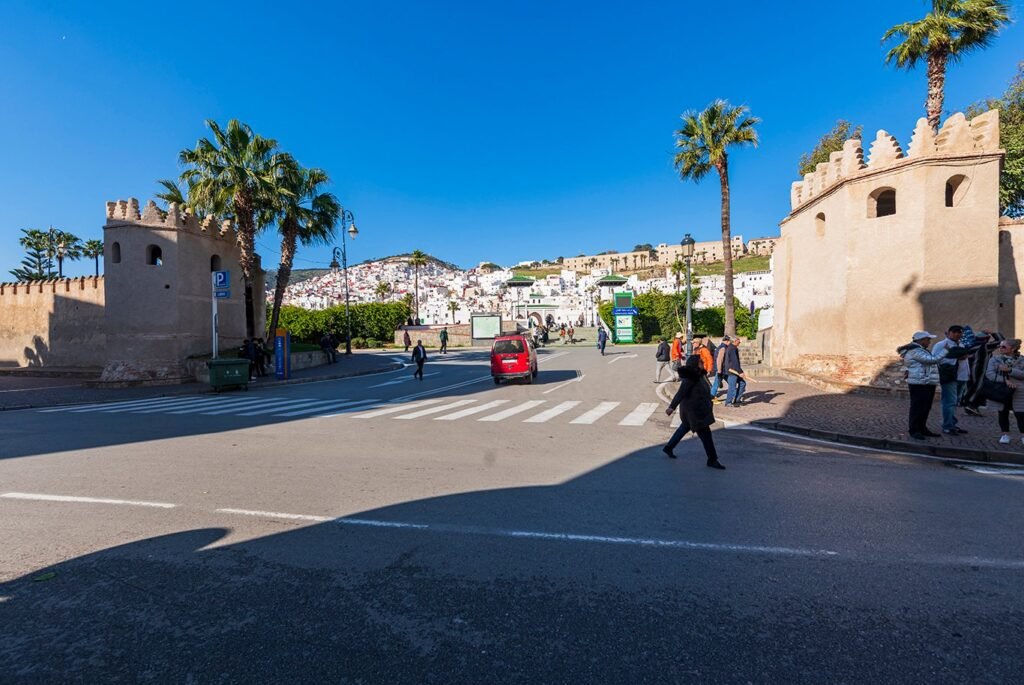
This UNESCO distinction is justified as follows: “The historic core of Tetouan is a remarkable example of a Mediterranean city, set against the mountainous landscape of northern Morocco.” It notes that “the strategic position of the medina of Tetouan, facing the Strait of Gibraltar, has played an important role as a junction and transition point between two civilizations (Spanish and Arab) and two continents (Europe and North Africa).” UNESCO also highlights that the site has “a very ancient occupation,” predating the Andalusian episodes that have made the city famous.
Tamuda, long before Tétouan
Yes, the appeal of the fertile Martil Valley has been a reality for centuries. One only needs to follow the river upstream—once known as Tamuda—to see for themselves. Today, that name belongs to one of the Kingdom’s most important ancient sites, located just a few kilometers from Tétouan.
In the early 1920s, Spanish archaeologists identified a structured set of ruins here, dating them to a pre-Roman era. Since then, research has deepened, revealing the layers of a complex past shaped by successive waves of occupation. The earliest traces go back to the time of King Baga (late 3rd century BCE), in what appears to be one of the oldest urban strongholds of Mauretania—an ancient political entity established in the northwest of Africa.
Rome’s expansion into this territory in the 1st century BCE did not mark the end of Tamuda—quite the opposite. Thanks to its strategic geographic position, the site was fully reinvested by the Romans, who turned it into a significant maritime outlet and a commercial crossroads within the Volubilis-Tamuda-Lixus triangle (near present-day Larache).
At the entrance to the site, along the RN2 national road, a stone arch still stands—a proud symbol of Tamuda’s Roman legacy. It rises defiantly among the ruins, outlining the shape of an ancient city that once played a significant role in Morocco’s long and layered history.
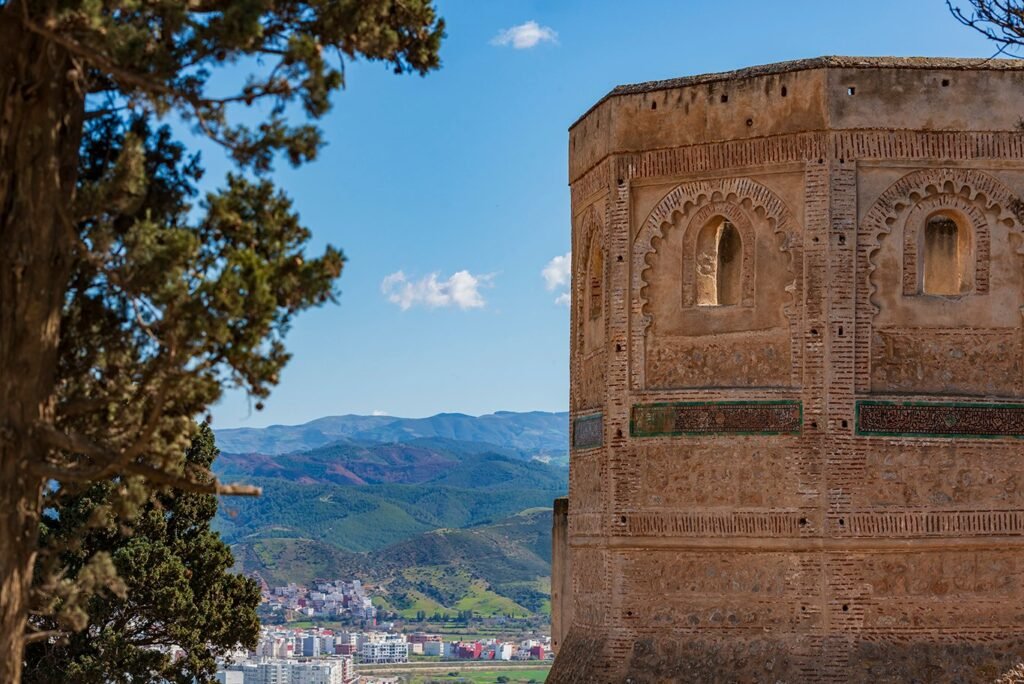
From the 3rd century onward, the Roman Empire’s grip on the locality weakened and, according to the latest archaeological findings, the militarization of the region intensified to the point of transforming the Tamuda site into a fortified camp. The end of the city’s life is thus marked by traces of violence, notably fires, as identified by researchers.
What remains of Tamuda’s treasures, a central witness to Morocco’s Antiquity, can now be seen at the Archaeological Museum of Tétouan. In this institution founded in 1940 — one of Morocco’s oldest modern museums — an upstairs room is entirely dedicated to Tamuda. Displayed there are tools, amphorae, and steles with Libyco-Punic inscriptions, testifying to the city’s rich and turbulent past. The museum’s location itself reinforces its status as a transmitter of history: situated between the medina and the Spanish city center, it stands at the crossroads of two worlds that only Tétouan manages to blend with such elegance.
The Ensanche, the old “new” district
Strolling through the streets of Tétouan’s Spanish district is truly an experience worth the detour—no pun intended. Along Mohammed V, Algiers, or Crown Prince avenues, keen-eyed visitors slow their pace, lift their heads, and scan the pristine façades of the surrounding buildings. More accustomed to this movie-set-like environment—also a living catalogue of architectural styles—locals walk at a brisker pace. Wide, impeccably clean sidewalks, vast flowered squares, and smooth, subdued traffic define the daily rhythm of the Ensanche, the historic district of modern-era Tétouan. It was in this old “new” quarter that the Spanish concentrated their efforts to enhance the city of Tétouan, declared the capital of their northern Moroccan Protectorate established in 1912.
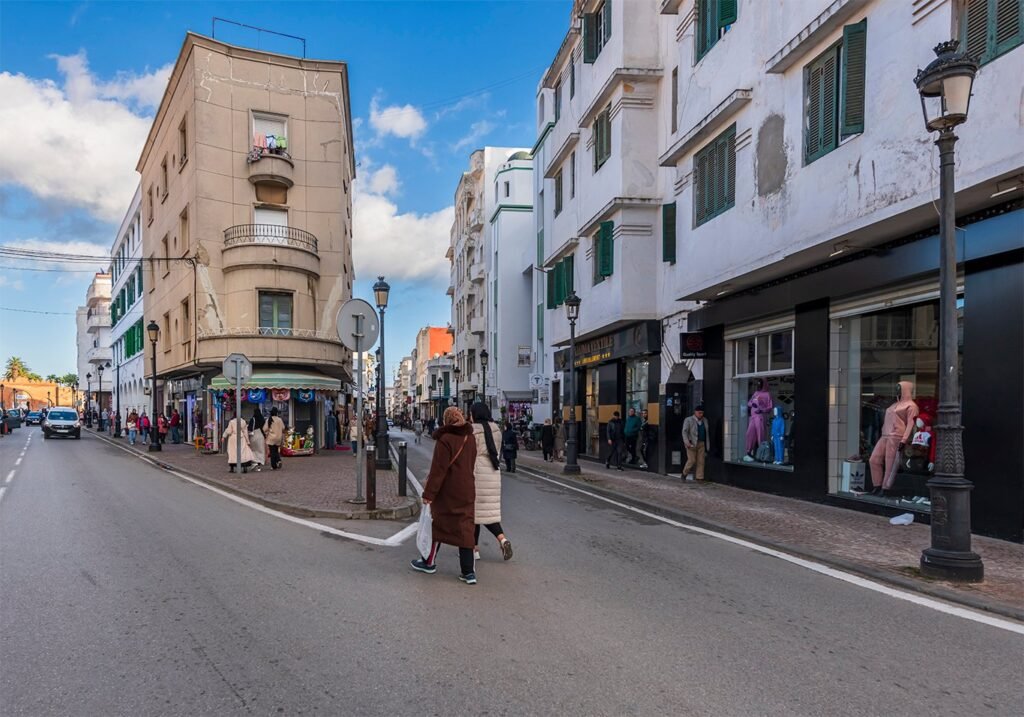
At that time, the Spaniards did not arrive on unknown land. They had known and feared rebellious Tétouan for centuries, but only truly measured its resistance in 1860. That year, the Sharifian and Spanish armies fought the largest battle of the 19th century on Moroccan soil. It ended with the victory of the Iberian troops, who occupied the city for two years. During this brief period, although the victors did not undertake any major urban works and only built military posts around the old medina, they were already envisioning grand plans.
This early projection is reported by the urban planner Mohamed Métalsi, author of the essential Tétouan, entre mémoire et histoire (2004, Malika editions). He revisits the consequences of the 1860 Tétouan War: “Morocco and Spain signed a peace treaty and implicitly delayed direct administration of Tétouan by Spain by fifty years, which would later trigger considerable urban transformations. In short, those two years of occupation were not enough to start major projects.” Deprived of the privilege of possessing Tangier—whose status as an “international city” was formalized in 1906 by the Algeciras Conference—the Spanish colonial enterprise then set its sights on Tétouan.
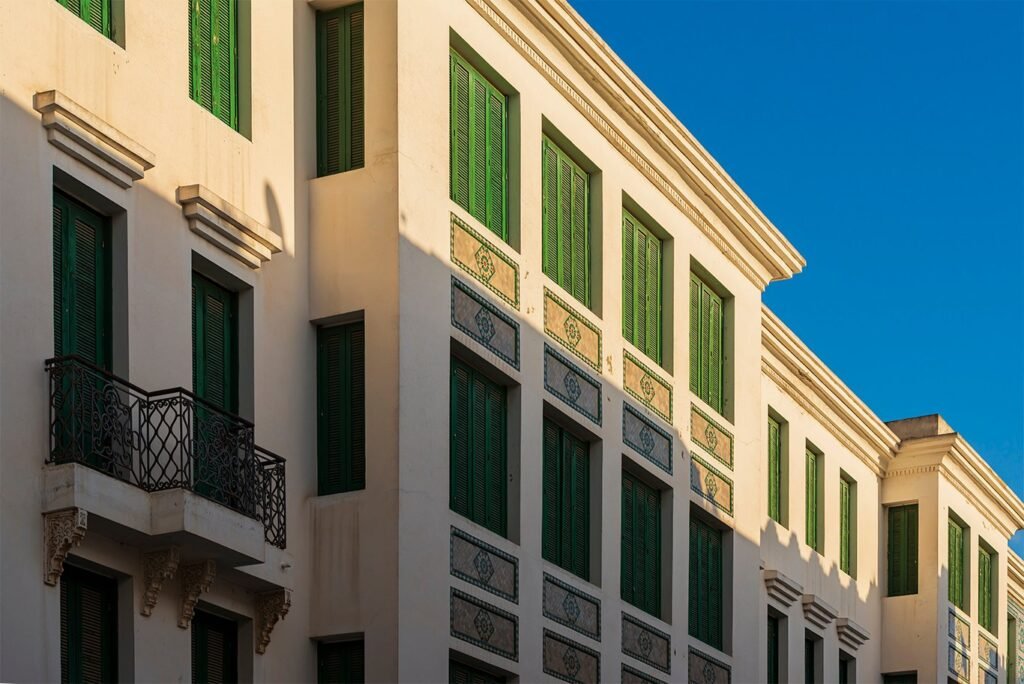
And unlike the urban policy advocated by the French Protectorate, the boundary between the Muslim and colonial neighborhoods here is deliberately much more blurred. Before exploring the porous junction between these two urban centers of Tétouan, let’s focus on the character of the Ensanche, which represents an essential element of the city’s rich heritage. Its name literally means “expansion” in Spanish. It refers to a trend in Spanish urbanism, emerging between the 19th and 20th centuries, involving the extension and modernization of the immediate surroundings of historic centers. And that is exactly what unfolded in Tétouan upon its proclamation as the capital of the northern part of the Spanish Protectorate.
Also called “El Chanti” by the people of Tétouan, the Ensanche covers an area of about 30 hectares, crossed by straight streets and avenues that challenge the sometimes steep slopes of the city center. The starting point of this urban journey through time is the remarkable Feddan Park, located at the northern edge of the Spanish quarter.
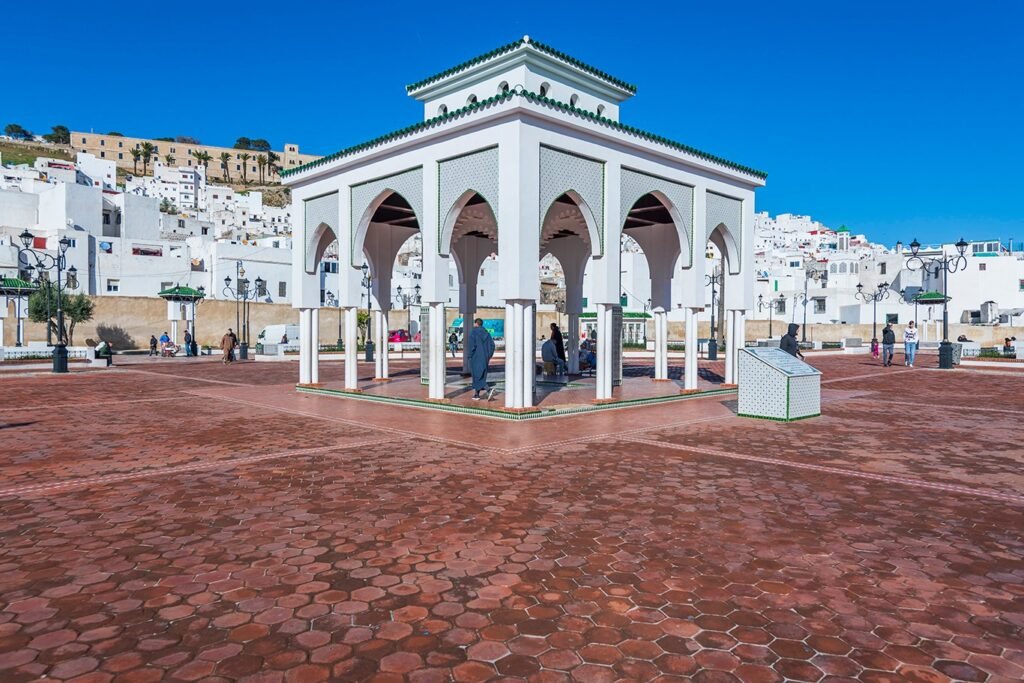
This vast square esplanade is one of the most welcoming spaces in the city, offering families, children, and casual strollers a place to relax and enjoy leisure activities. Designed like a gigantic Andalusian house patio, paved across its entire two hectares, the square is accessible from Avenue d’Alger, itself surrounded by well-maintained ancient ramparts. Beneath your feet, a clever underground parking lot capable of accommodating nearly 500 vehicles effectively helps ease parking congestion in the Ensanche while ensuring close proximity to the historic medina.
Also called “El Chanti” by the people of Tétouan, the Ensanche covers an area of about 30 hectares, crossed by straight streets and avenues that challenge the sometimes steep slopes of the city center. The starting point of this urban journey through time is the remarkable Feddan Park, located at the northern edge of the Spanish quarter.
The Spanish Inn
At the center of the square, outlined by a giant circle made of ochre tiles, an elegant building resembling a mausoleum adorns the esplanade. Fine zellige, vaulted arches supported by white columns, stucco muqarnas, and green tiled roofing — the construction embraces a distinctly Moorish style. Nearby, a marble stele commemorates the inauguration of this space by King Mohammed VI on July 30, 2016, during the Throne Day celebration. Indeed, on several occasions, Tétouan has hosted the Al Baya’a ceremony (Oath of Allegiance), reflecting the Sovereign’s deep affection and high regard for the city, the heir to Andalusian tradition.
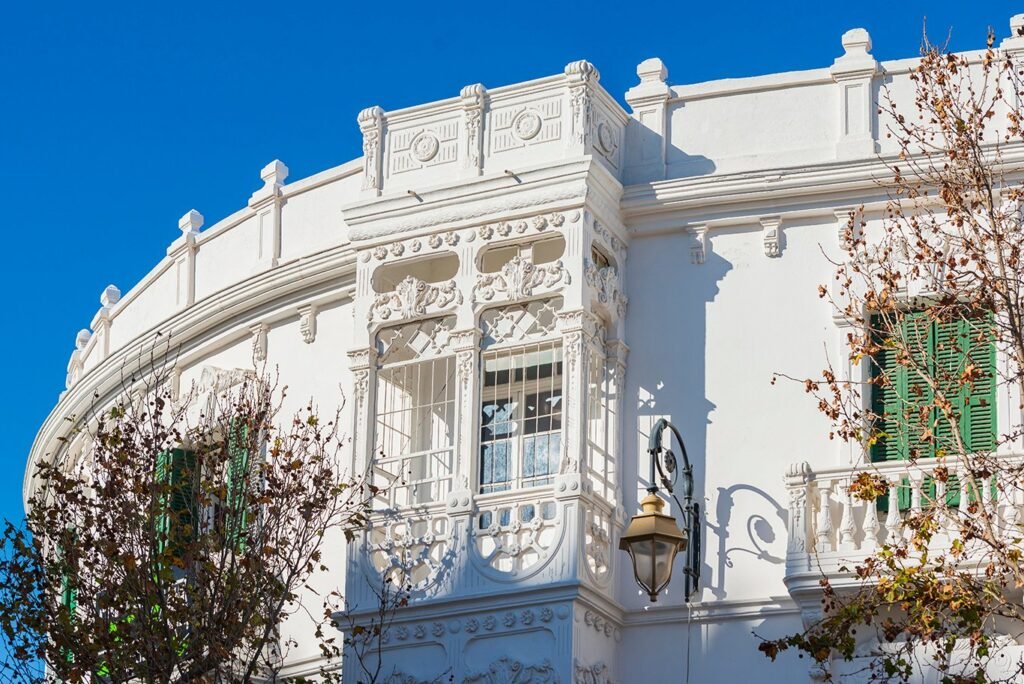
To the left of Feddan Square is a place that has become an institution among locals: the café-restaurant “Granada,” whose façade blends harmoniously with the surroundings. Behind it, a large playground completes the square, which has become the go-to spot for strolling during the cooler hours of the day. It also offers a stunning view of the traditional white houses perched on the lower slopes of Jbel Darsa, with, further upstream, the imposing ramparts of the Kasbah of Tétouan, masterpieces of military fortification currently undergoing restoration.
At this crossroads, Feddan echoes other squares, this time with a distinctly Spanish style. One such example is Moulay El Mehdi Square, a spectacular terminus of Ben Aboud Avenue from Feddan Park. A circle within a circle, with tall palm trees in the center of the roundabout resting on a carpet of green grass, acting as natural guardians of a fountain tiled in turquoise. The urban heritage is spread around this hypnotic square like a necklace of pearls.
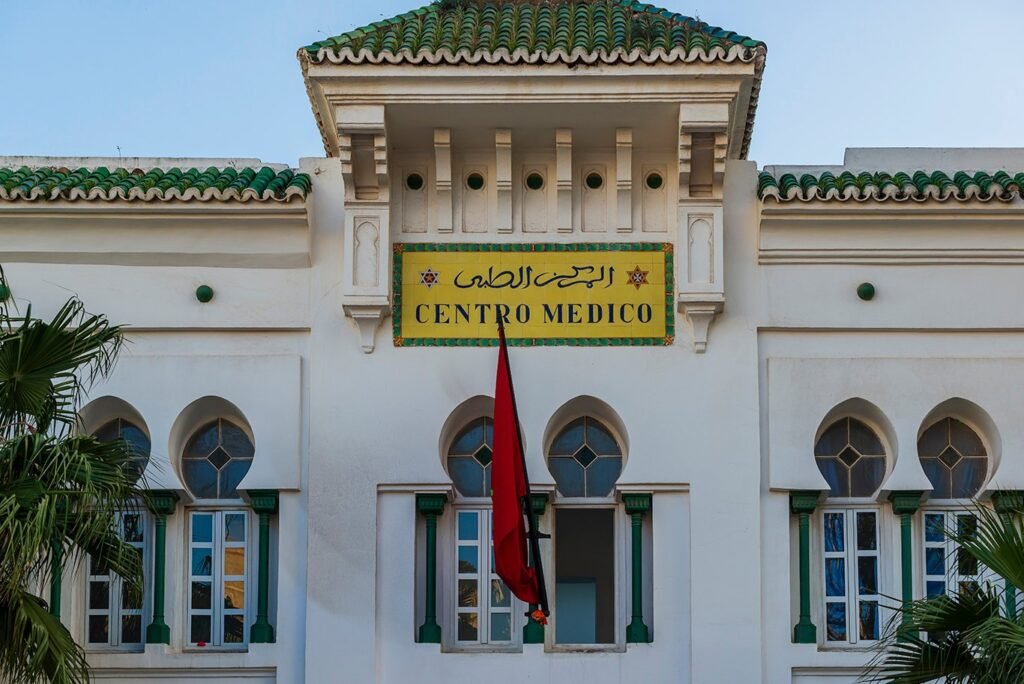
Despite its central position in the heart of a particularly busy commercial district, Moulay El Mehdi Square is a major spot for Tétouan’s leisurely strollers, with its spotless white buildings perfectly embodying the Hispano-Moorish style, its cafés with lively terraces well into the night, and its imposing structures housing, among others, bank agencies and the graceful Spanish consulate. The feeling of wandering through a mid-20th-century European capital is heightened by the highlight of the scene: the very solemn Church of Our Lady of Victory, the square’s only isolated building, distinguished by its neo-Gothic style and soaring bell tower. Clad in an unusual sulfur-yellow color, the city’s main Catholic place of worship, built in 1925 on the site of a hastily constructed chapel from 1860, has lost none of its grandeur and continues to testify to the exemplary religious diversity of the Moroccan city, a worthy heir to Al-Andalus.
From Moulay El Mehdi Square, named after the former Khalifa (delegate) and cousin of Sultan Moulay Youssef in Tétouan, the royal avenue follows the course of Avenue Mohammed V towards the medina. A feast of architecture awaits the discerning walker along the Ensanche’s main artery, where the Hispano-Moorish orientalist style, Art Deco modernism, and the so-called eclectic style characteristic of the Francoist period succeed one another. Each style, reflecting its era, today contributes to the unique identity of Tétouan’s city center. As much as the diversity of this anthology of early 20th-century architecture, it is the remarkable state of preservation that fascinates visitors. Between freshly repainted facades and regularly highlighted sculpted or wrought details, how has Tétouan succeeded where other cities in the kingdom struggle to showcase their urban heritage?
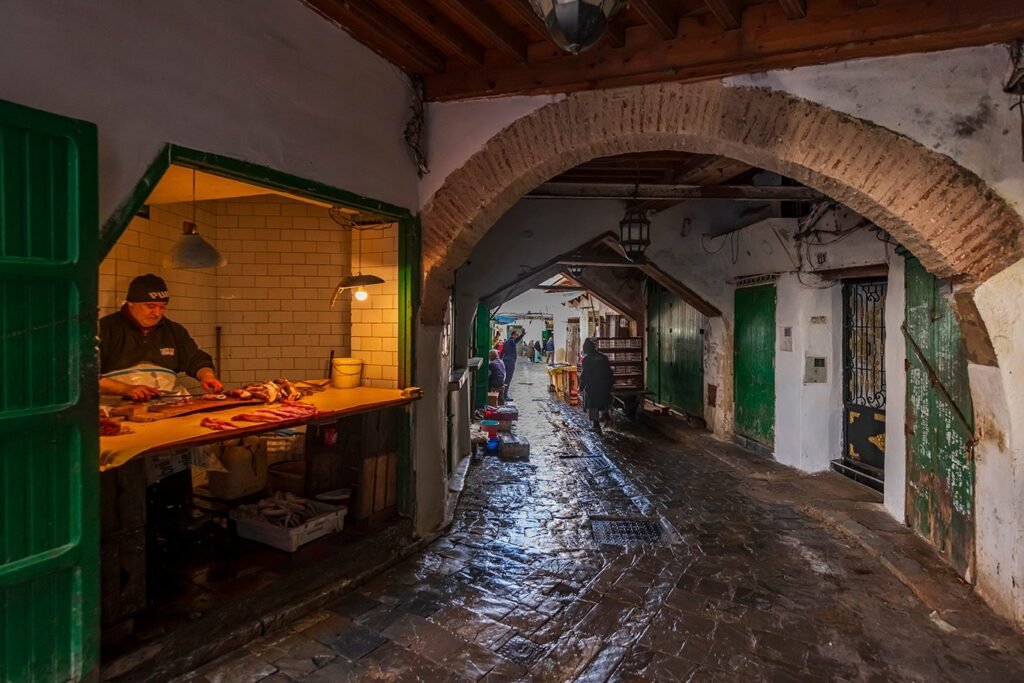
M’hammad Benaboud, vice-president of the Tétouan Asmir association, offers us an element of the answer. The co-author of Tétouan, Ville andalouse marocaine (CNRS éditions – 1996), alongside Islamic architecture specialist Nadia Erzini and the indispensable historian Jean-Louis Miège, simply explains that “Tétouan is maintained because we are committed to preserving its heritage, identity, and unique charm. Associations like ours have been working towards this for about thirty years, providing constant efforts in classification, rehabilitation, and restoration.” This patient and meticulous work has been energized by the “integrated economic and urban development program of the city,” launched by King Mohammed VI in 2014. Extending beyond the Spanish quarter, this program also concerns the medina, the true historic city center of Tétouan and the next stop on our stroll.
But before diving into the heart of the old medina, Mohammed V Avenue leads us to a grandiose space, a usual protagonist of the city’s postcards. As the asphalt literally gives way to cobblestones and the path widens, you are about to enter the fabulous El Mechouar Square, a place of great celebrations for centuries. While you glimpse in the distance the majestic facade of the Royal Palace, take time to admire the last colonial-era buildings which, in a singularly harmonious transition, give way to the authentic Andalusian medina. On El Jala Square, a necessary passage to El Mechouar, stands a cannon from a bygone era, when Tétouan was still involved in the troubles of war and intervals of peace.

To its right stands a building of dazzling whiteness, featuring an admirable door inspired by Moorish design. But what truly sets this building apart and immediately captures visitors’ attention is undoubtedly the unusual statue perched atop its central tower. It depicts a bare-chested man, fist raised, boldly riding a gigantic bird that could be an eagle or a phoenix—poetically called “Dar Taïr” by the people of Tétouan, literally meaning “the House of the Bird.” The origin of this intriguing statue, extremely rare in Moroccan urban landscapes, lies with private developers. Dispelling many legends, M’hammad Benaboud explains that “most people here don’t know that this work dates back to 1944 and that it was created to adorn the headquarters… of an insurance company.”
El Mechouar, the Embrace of Cultures
Behind the block formed by “Dar Taïr,” a small detour is worth taking to admire one of the oldest cultural buildings in contemporary Morocco and a landmark beloved by the people of Tétouan. We are referring to the cinema-theater hall “Teatro Español,” built in 1913, making it one of the first public buildings erected by the Spanish Protectorate. This is further proof that the occupiers’ intentions were not limited to militarizing their North African “capital” but also extended to firmly establishing their presence there.
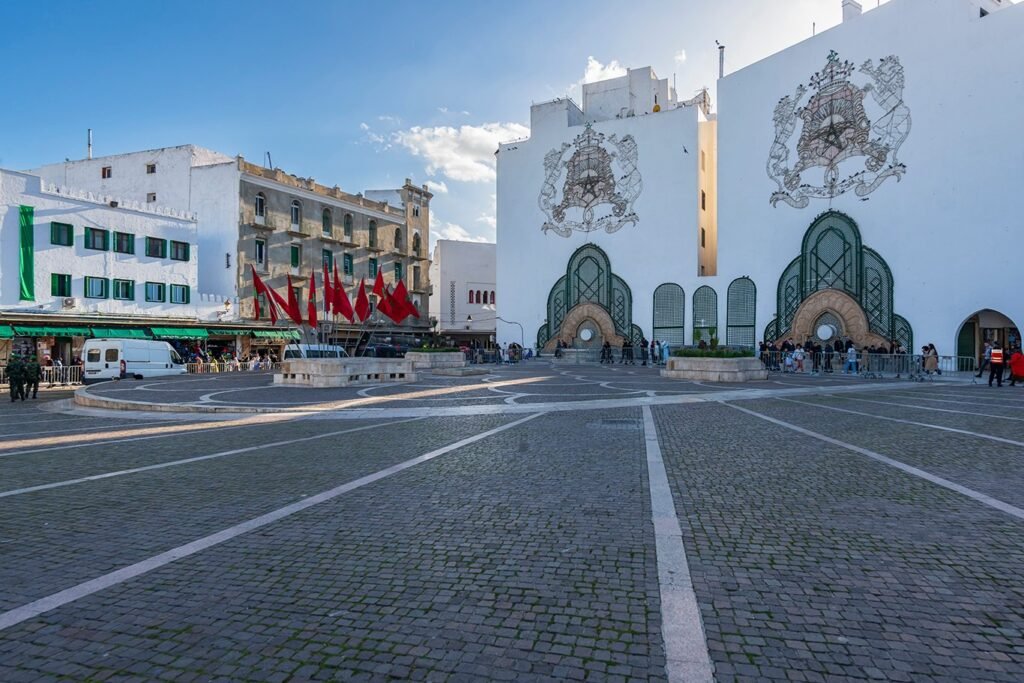
Obviously, the original purpose of this heritage site was not the seventh art, but rather theater and flamenco performances. Cinema only took hold there from the 1940s onward, until the decline of Moroccan theaters as the new millennium approached. Renovated in 2018, the Teatro Español is now the annual host of the Tétouan Mediterranean Film Festival, a flagship event that illustrates—if any proof were still needed—the city’s deep attachment to arts and culture.
But let’s return to the impressive stage of El Mechouar, just a few steps away, where the spectacle is constant, day and night, thanks to a light scenography that highlights the sublime esplanade of the Royal Palace. In front of the gate that restricts access, tourists and visitors pull out their phones and cameras to capture the magic of the place, a junction of all Tétouan’s influences. Surrounded by the latest buildings of the Ensanche, the front façade of the Royal Palace is enhanced by a door as beautiful as it is grandiose.
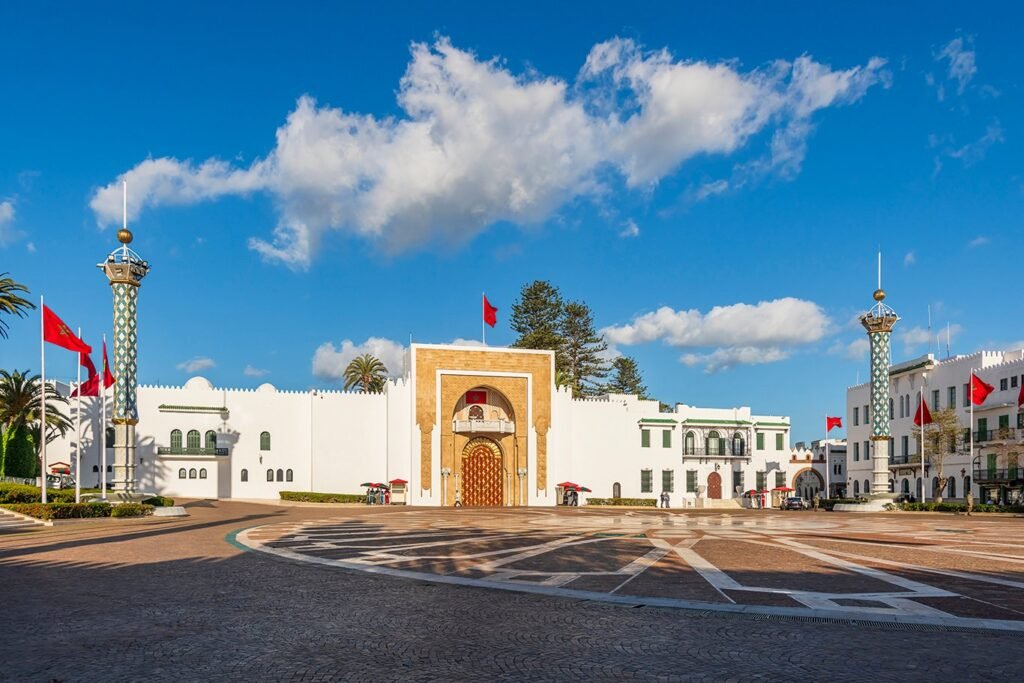
The Moroccan flag flies atop this majestic entrance, framed by two posts sheltered by umbrellas, beneath which stand members of the illustrious Royal Guard. Dressed in their striking red uniforms and clad in immaculate white selham cloaks, these representatives of the world’s oldest active military corps complete this picturesque scene, set against the bright yellow of the immense arched gate. The rest of this living tableau rests on a simple white façade, whose clean aesthetic is only broken by elegant windows and a Moorish-style belvedere. Built in 1740, this complex was renovated at the beginning of the 20th century to serve as the residence of the ‘Khalifa’, before becoming the royal residence in the city following independence.
After several minutes of contemplation, an irresistible pull guides us towards the medina to which this historic and architectural gem is attached. To do so, you must follow El Mechouar to the right, where a lively and colorful alley leads to Bab Rouah, the main western entrance to the old city. Immediately, the medina reveals its distinctive features. A charming alley shaded by delicate pastel green mashrabiya screens, and especially signs warning of the inherent disorientation in the labyrinthine alleys ahead. You learn that the synagogue at the heart of the Mellah, the traditional Jewish quarter, is to your right. And if you keep going along Mohamed Ben Larbi Torres Avenue, named after the former diplomat who led the Moroccan delegation to the 1906 Algeciras Conference, you plunge into the very heart of Tétouan’s historical origin.
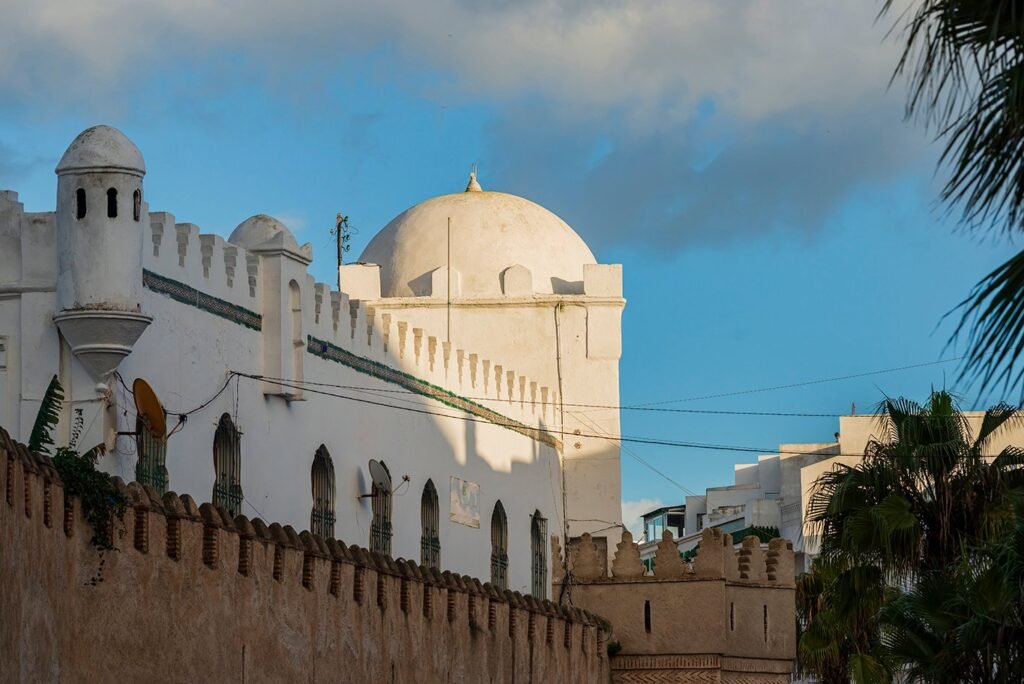
Even today, researchers and historians struggle to provide a definitive founding date for the city. In his book, Mohamed Métalsi points out that illustrious figures such as Ibn Khaldoun, Al Bakri, and Al Idrissi mentioned the existence of a “small fortress with military and strategic functions” that appeared during the era of the “principalities” which succeeded the Idrisid dynasty at the end of the 10th century. Like other urban sites in the region, the ancestor of Tétouan “suffered competition from Sebta, located only 40 kilometers away,” then the undisputed leading city of the northern Kingdom. It was not until the mid-13th century that significant development took place, when Sultan Abu Yusuf Yaqub (1258–1286), founder of the Marinid dynasty, undertook to transform the stronghold into a true kasbah.
The purpose of this growth was to establish a first connection with the legendary Al-Andalus, as Tétouan became one of the many “ribats” — these launch bases for expeditions to Spain. Today, the traces of this role remain mostly visible in the kasbah, before the city adapted once again to the upheavals of history, namely the shifting balance of power between the southern and northern shores of the Strait of Gibraltar. The real turning point came in 1417, with the Portuguese capture of Sebta, which prompted the city to become a center of resistance.
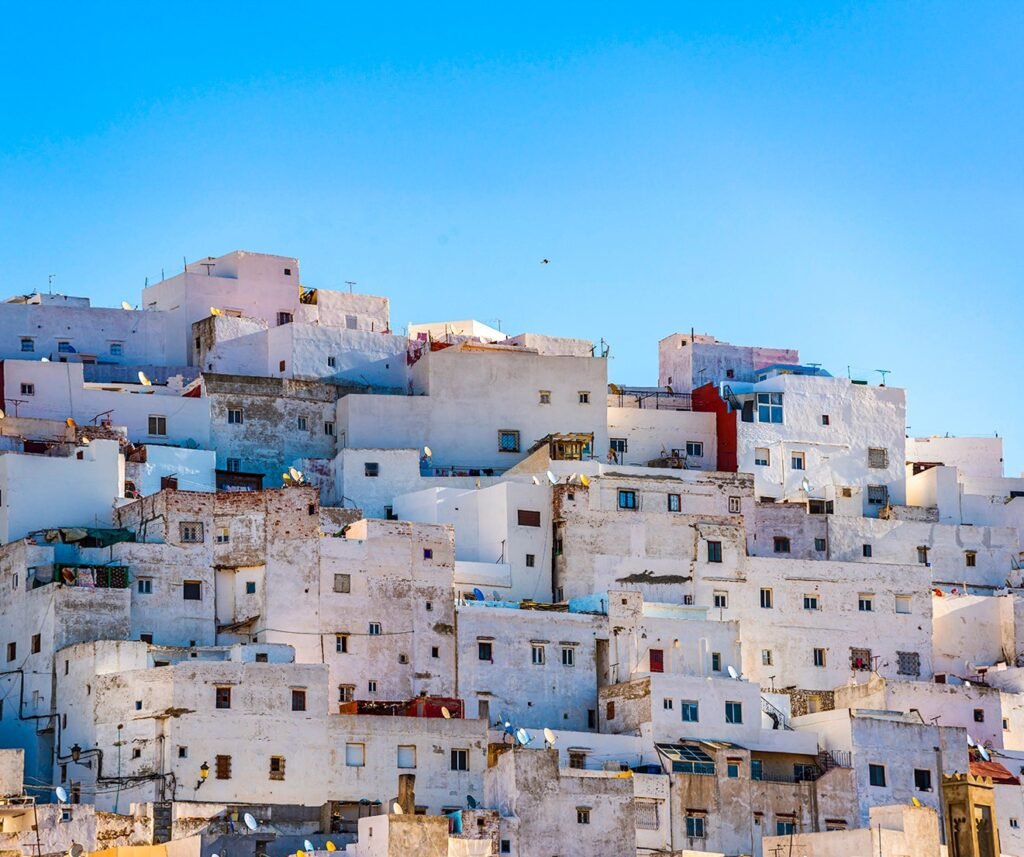
A momentum that ultimately turned against Tétouan: twenty years later, it was the first to bear the full brunt of the violent Lusitanian counterattack. For the first time since its founding, the city was on the brink of collapse, emptied of its inhabitants who were forced to flee the Portuguese raid. It was also an opportunity to wipe the slate clean and launch a fresh momentum. “The reconstruction of the city was a strong act. An action that at the time could only be led by the royal power or its representative. But the pressing historical necessities were exceptional. The danger coming from the north and the collapse of the Moroccan central authority allowed Andalusian immigrants, with the endorsement of the chief of Chaouen, to build an autonomous city,” explains urban planner Mohamed Métalsi.
Since the mid-15th century, a new population sought to contribute to Tétouan’s revival. These were, of course, the inhabitants of Al-Andalus, but before them, an elite group of soldiers—the Mudéjars—served as scouts. These intrepid horsemen from Granada, led by their chief Abou Hassan Ali Al Mandari, settled in Tétouan in 1493, determined to continue their fight against the Christian forces of the Reconquista. The era of the Al Mandari clan, which gave Tétouan its nickname “Daughter of Granada,” was in fact dedicated to building a city in their image—this time on the African continent. Thus, Tétouan was fortified with strong walls, which visitors can still see surrounding the medina. Other waves of migrants from the north increased the city’s population from the early 16th century, followed by mass exoduses of Moriscos (Muslims expelled from Spain).
A medina unlike any other
From then on, the layout of the medina reflected expertise brought from elsewhere. “With its relatively octagonal shape, it contrasts by the regularity of its straight alleys and dead-ends with the tangled networks of other Moroccan medinas, reflecting the mentality of its Morisco builders, influenced by the ideas of the Spanish Renaissance,” details Mohamed Métalsi. But can we assume the exclusive Andalusian identity of Tétouan? M’hammad Benaboud prefers to add nuance. He reminds us that “the city has undergone many other influences, notably that of the Jewish community, as evidenced by its cemetery, the oldest in Morocco dedicated to this community, and its mellah, now fully restored.” He also cites the influence of “Algerians fleeing the French occupation in the 19th century, the Amazigh people of the region, the rural population of the Jbalas, and naturally other Moroccan cities, especially Fès.”
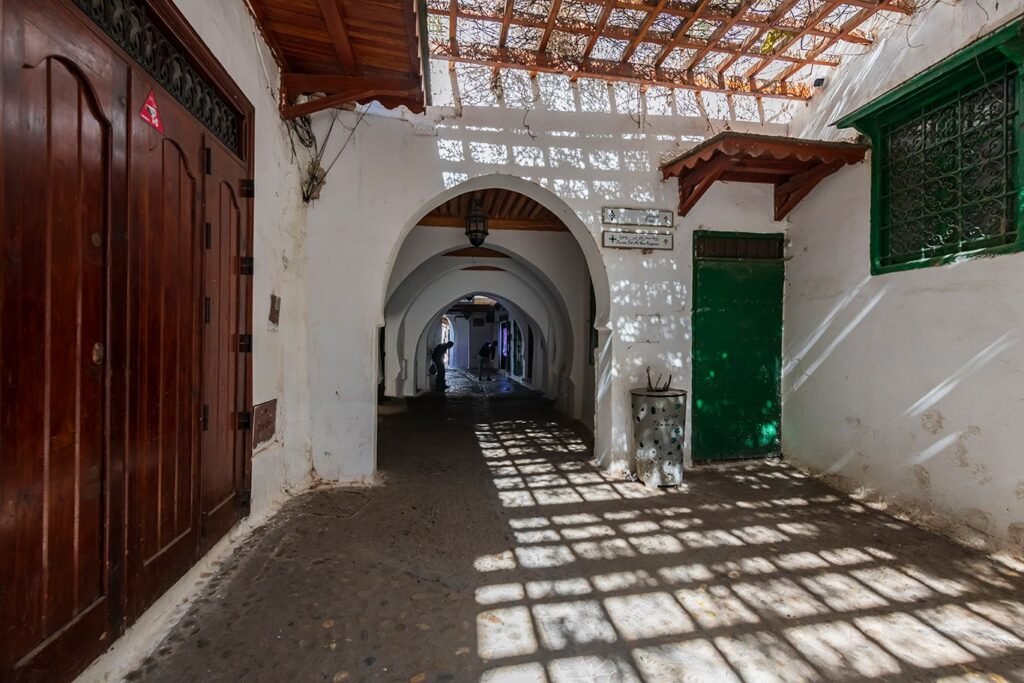
It is this multicultural crossroads that the rehabilitation efforts, whether undertaken by associations or the state, have perfectly illustrated and enhanced. During your stroll through the city’s alleys, you will notice many plaques embedded in the walls near doors that you might otherwise consider ordinary. These plaques detail the nature of the building, the date of its construction, and sometimes its former function. This is the case for zaouïas (religious brotherhood gathering places), mosques, public baths, and even markets that are still active. And if your curiosity leads you to learn more about the rich heritage of the medina, head to a place that reveals like no other the intimacy of a typical Tétouani house.
At the end of Mohamed Ben Larbi Torres Avenue, after passing through the jewelers’ quarter, a sign points to “Dar El Oddi – Cultural Space,” whose entrance door appears around a simple alleyway. The uniformity of the old city’s whitewashed walls is immediately broken as soon as you step inside this museum, a remarkable witness to the bourgeois houses abundant in the medina. Black and white tiled floors, walls adorned with zellige shaped like rosettes, and at the back of the central patio, an Andalusian salon nestled behind finely sculpted arches: this is what the ground floor of a residence looks like which, like so many others in the city, modestly hides its wonders.
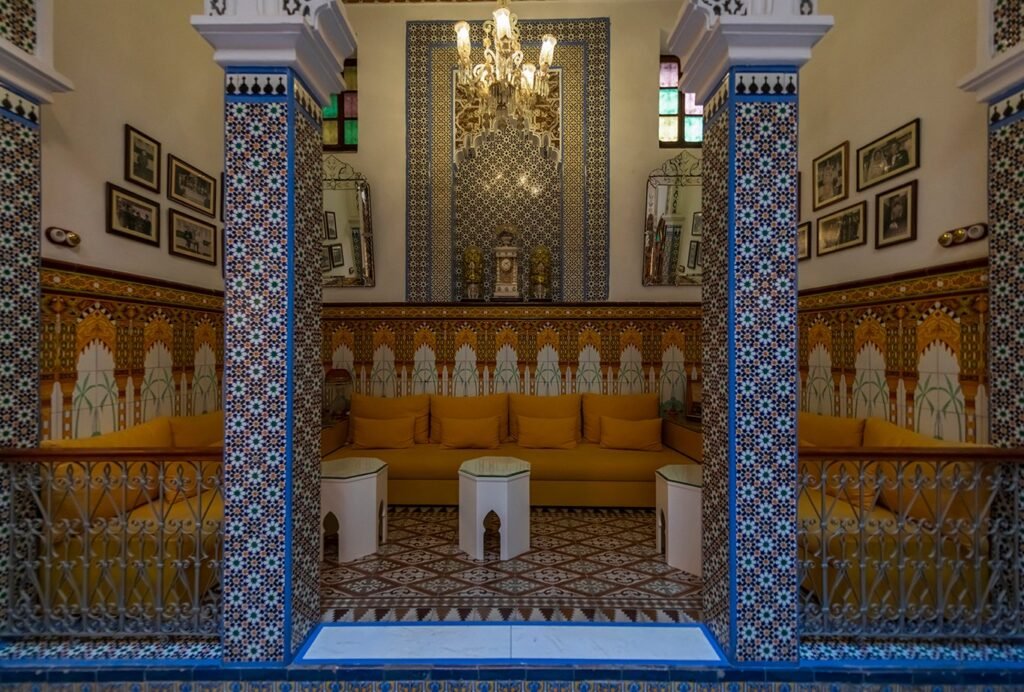
As its name suggests, “Dar El Oddi” is the property of the El Oddi family, fully restored by one of its descendants, Jalal, who is endlessly passionate about the house where he was born. An industrialist based in Casablanca, he said he felt the need to “reconnect with his past and his city,” and therefore decided to “renovate the family home, turn it into a museum, and open its doors to visitors curious about the city’s heritage.” This endeavor proved “complex but wholly satisfying,” because after a period during which it was left uninhabited, this house “has regained a soul.” The idea of opening it and making it a house museum is not only to showcase a typical residence but also to retrace a chapter of Tétouan’s history and its medina.
Thanks to an impressive collection of photographs and original or reproduced paintings, some dating back to the 18th century, Jalal El Oddi called on professional scenographers to set up a permanent exhibition. Titled “Landscape of Tétouan,” it adopts a very specific approach, as explained in its text: “Travelers approach Tétouan by sea, via the Sebta route or the Tangier route. Their viewpoints reflect the beauty surrounding them: the mountains, the plain, or the river that frames the city.” The exhibition presents the perspectives of outsiders on the city and illustrates its evolution over time. To feel its essence even more, you must climb the stairs, where a beautiful terrace offers a spectacular view—not only of the medina but also of the Martil river valley, which you can follow with your eyes all the way to its Mediterranean mouth.
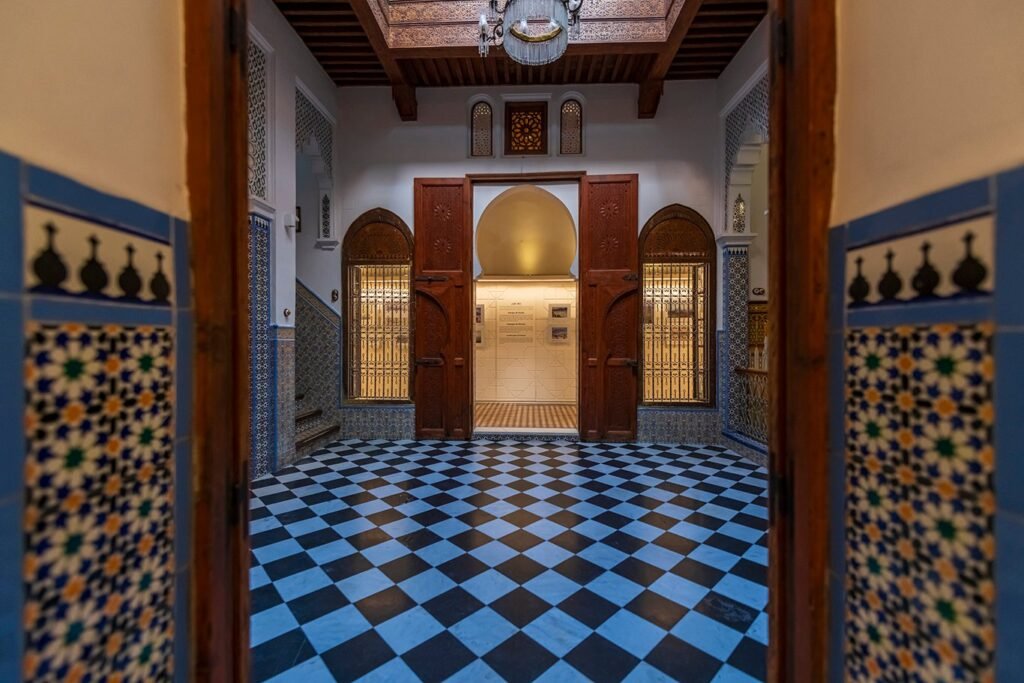
Another museum rich in information awaits you if you continue your wanderings further west until you reach Bab El Okla, one of the eight historic gates of the old city. Near this imposing monument, nestled within a bastion dating from the early 19th century, numerous signposts direct you to the “Bab El Okla Ethnographic Museum.” This place, while also telling a story of the arts and crafts of Tétouan, is itself a witness to the ideological and semiological violence of the colonial era that named it at its creation in 1948 the “Museum of Indigenous Arts.”
After undergoing successful restoration and receiving a more appropriate name, this large cultural complex, under the patronage of the National Foundation of Museums, is the ideal place to understand all the subtleties of Tétouan’s unique culture. Walking through its numerous rooms spread over two floors, you will learn all about wood carving and motifs inspired by those popular in Seville, Cordoba, or Granada during the Andalusian golden age. The same applies to the art of embroidery, which has given rise to true masterpieces displayed in glass cases, such as an incredible traditional Jewish costume, or a sublime “chedda,” a women’s bridal outfit of astonishing complexity.
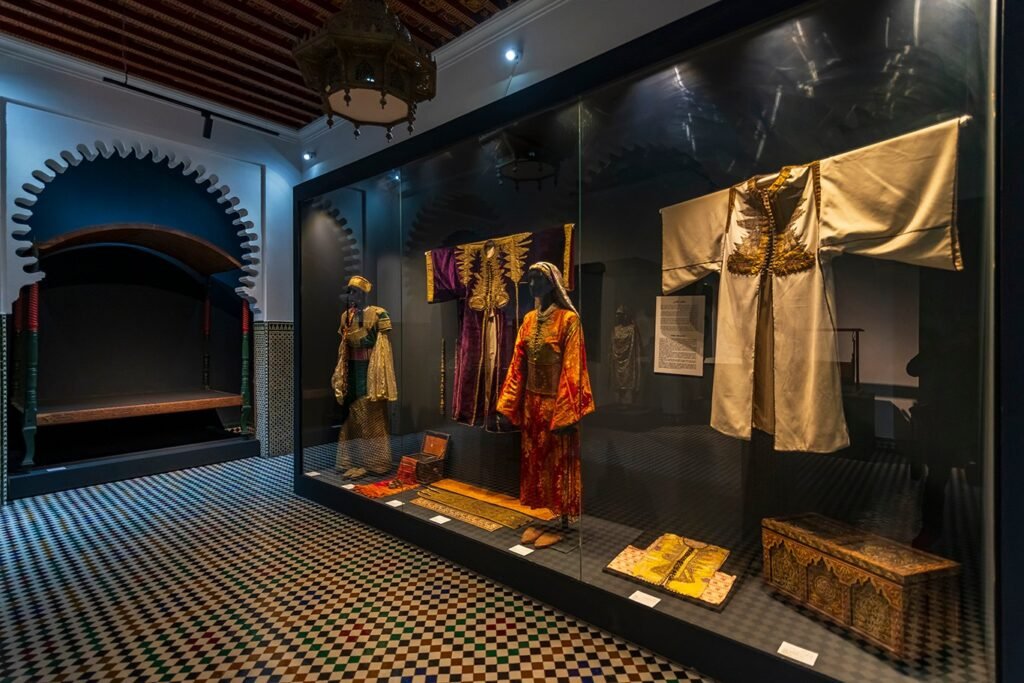
The museum explores many other fields, such as the tradition of manuscripts in Tétouan, a refuge city for scholars, as well as its rich musical heritage. Called “Al Ala,” or more simply “Andalusian music,” this musical genre is based on a repertoire shaped by instrumental openings (violin, lute, and percussion), sung poems, and improvised refrains, following a musical system called “Nawba.” In this domain, the city is not merely a branch of the Andalusian musical tradition but has become, over the years, a center of this refined art, producing legends like Larbi Tamsamani, former director of the Tétouan Music Conservatory, the illustrious Abdessadeq Cheqara, and the brilliant lute player Mokhtar Mfarrej.
The Medina of Tétouan is full of heritage trails that will lead you to the great gates punctuating the city walls, passing by centuries-old mausoleums, historic mosques, and traditional tanneries. Plan at least a full day to explore its secrets, and enhance the experience by staying in one of its many riads—the best way to immerse yourself in the spirit of this unique city. To understand why the “White Dove” became the remarkable extension of a civilization forced into exile, you must venture forth and follow the Martil River to its mouth.
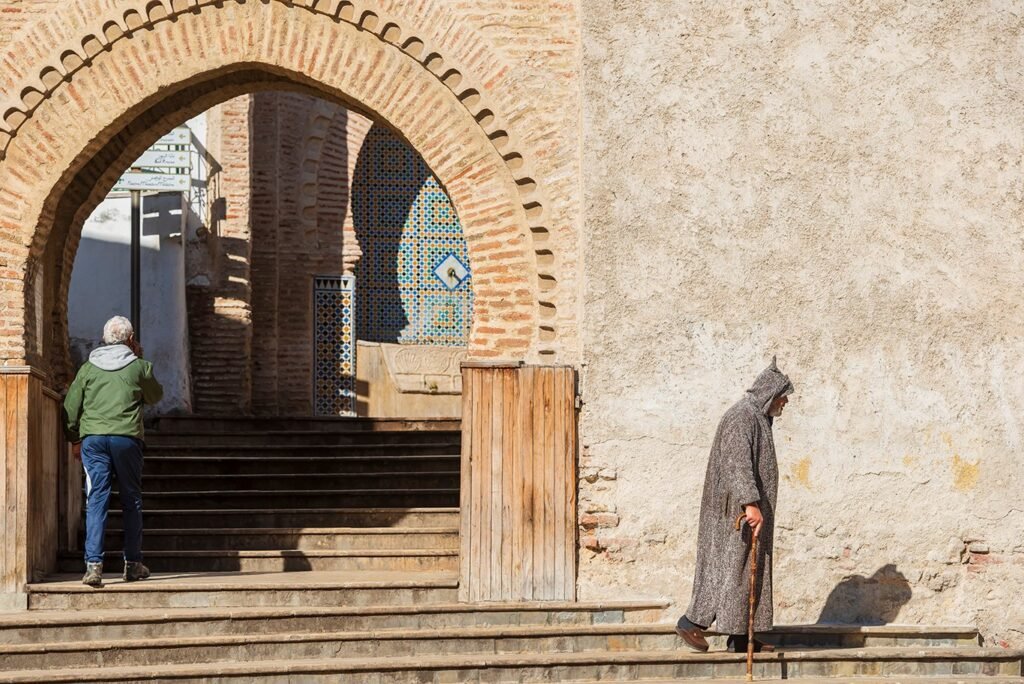
To reach this, a short twenty-minute drive on a wide expressway is enough, and you find yourself in what is probably the most popular seaside resort for Moroccan vacationers. But before serving as an idyllic holiday setting, the place commonly called “the port of Tétouan” actively contributed to the city’s prosperity. While the white sandy beach dotted with deckchairs today invites summer leisure, between the 16th and 18th centuries, this location was feared by all Mediterranean sailors.
And for good reason, the city of Salé did not have a monopoly on piracy: it was brilliantly assisted by Tétouan, or rather by the site now called Martil. This place was home to intense corsair activity led by one of the main figures in Tétouan’s history. This was Sayyida Al Hurra, literally “the Free Lady,” who intermittently ruled the city between 1525 and 1542. She had forged an alliance with the corsair and governor of the Regency of Algiers, Arudj Barbarossa, harassed the Portuguese settled in Sebta, and contributed to the unprecedented rise of Tétouan and its surrounding region. At the time, the Martil River was navigable at its mouth, making the “Daughter of Granada” a powerful maritime city.
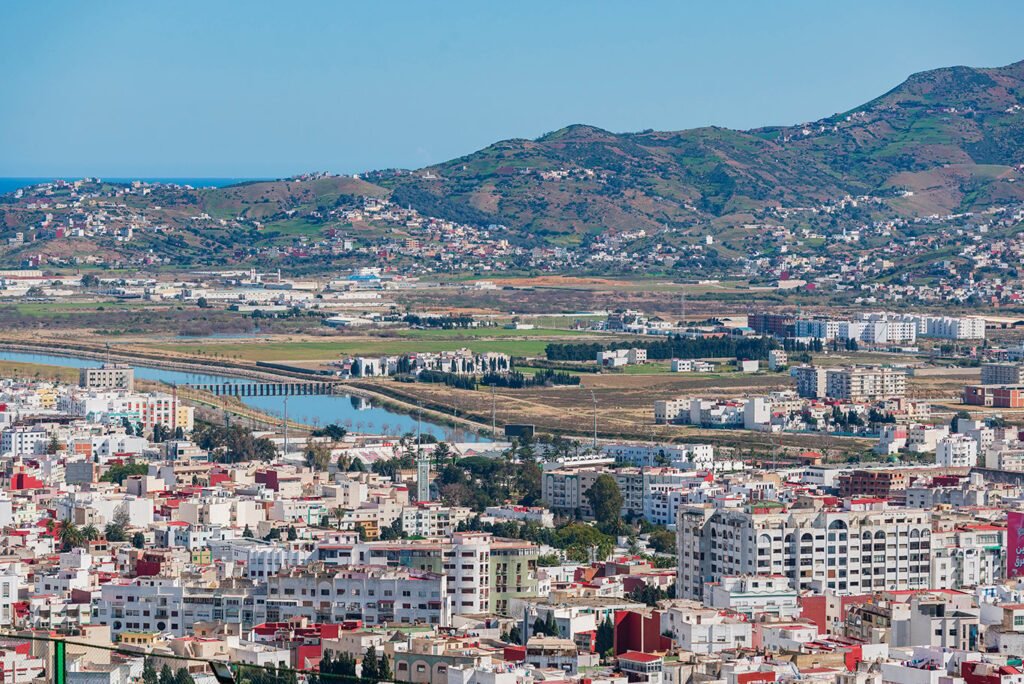
Nowadays, navigation here is essentially reserved for water sports and leisure on the vast beach that stretches from Cabo Negro to Ben Maâden, further south. A true little paradise echoing the subject of the poem by Abu al-Baqa ar-Rundi, which accompanied the exiles from Al-Andalus for centuries. But rest assured, the memory of this Eden has indeed survived, and it is still possible to admire it in Tétouan.
Source : LeDesk;ma
Translated by : ExploreTetouan
Need help or have questions about your trip to Tetouan? We’re here for you — just get in touch!

